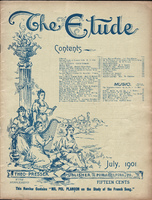An article appeared in these columns last issue urging the importance of American composers writing in the larger form. I desire to emphasize that need under the above heading.
The subjects commonly treated by the majority of those whose music has become popular among artists and students are either too brief or too trivial to afford the student a desirable stimulus. The need of dramatic songs is great, but not greater than of bright, rhythmical works in varied movements. It is very un-American to write more than two or three notes to a syllable, or so it appears, for we can count by the numerals all successful efforts in this direction. While the aria afforded a grateful relief from the conventional waltz-song of thirty years ago, the element of brilliancy found in both the waltz and the aria, which is of so much importance in the matter of discipline, is sadly lacking in the music now in vogue. Therefore in behalf of the teacher and the student, and especially of the American voice, I urge our native composer to let his numbers dance more merrily; to rouse himself from his sad and sentimental fancies and woo the nymphs and fairies; to harness his genius to the rhythms of Nature in her most animate moods; to study the cadenza as a legitimate, if obsolete, form of expression; to imitate the birds and give to us whole strings of notes on single vowels; in short, let us sing brightly and gaily at least a part of the time, not less for the sake of the voice than for the joy which is music’s most natural and precious attribute.
“A singer sang a song of tears
And the great world heard and wept;
For he sang of the sorrows of fleeting years
And the hopes which the dead past kept;
And souls in anguish their burdens bore
And the world was sadder than before.
“A singer sang a song of cheer;
And the great world listened and smiled;
For he sang of the love of a Father dear,
And the trust of a little child;
And souls that before had forgotten to pray
Looked up and went singing along the way.”



